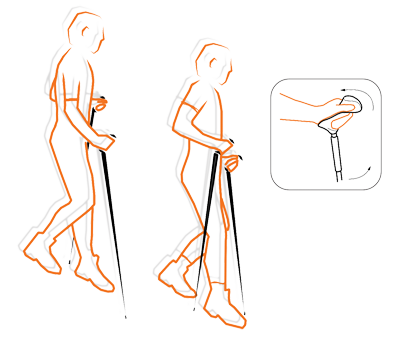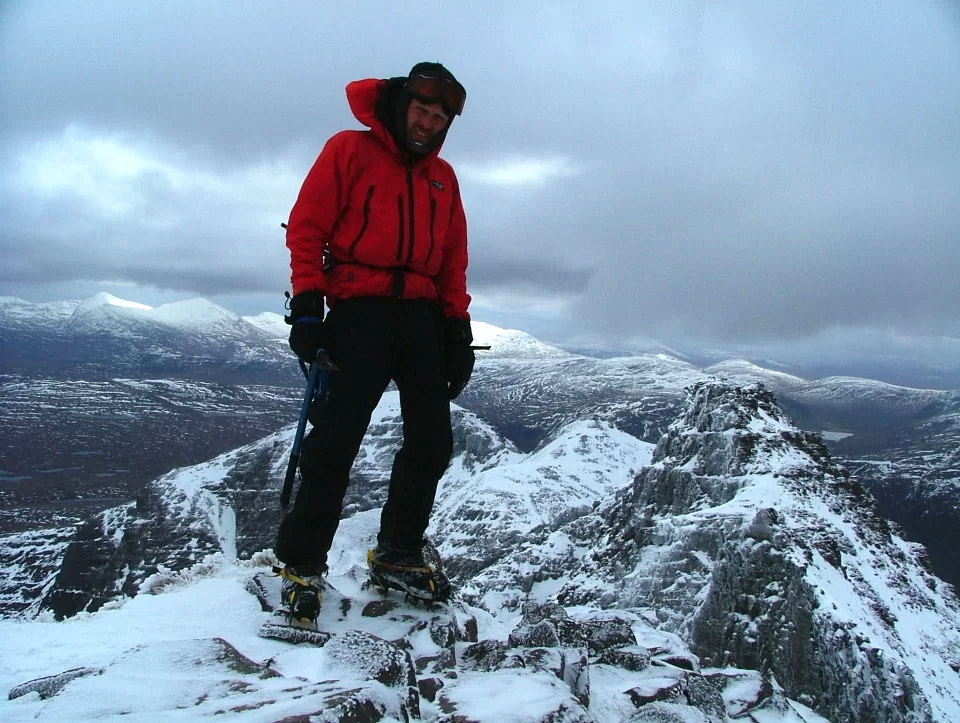BASIC DESCENTS
Always aim to keep the span between shoulder tip to shoulder tip as wide as possible i.e. not rounded forward or arched back. The habit of over-reaching the whole arm away from the body, with the shaft acting as a prop often stems from using conventional poles. Alternative actions better suited to using the whole of the body more effectively, can be controlled using Pacerpoles. As a general picture, the trunk is lowered on a descent like an upended box. Aim to keep this box aligned over your feet and not lean back too far or arch too far forward. When the right shaft and left leg move down-slope, the left elbow and right knee bend to lower and off-load the trunk onto this new support base in front. These points in ground contact are alternating beneath your ‘upended box’ for each step of descent; your general stride length will affect how efficiently (and safely) this happens. Decents/Stride Length:Taking longer strides on a descent increases the extent that the trailing knee/elbow has to bend in order to lower the trunk onto the advancing front supports. This increased range of movement at the joints, controlled by using ‘eccentric’ muscle work is tiring to sustain (safety factor) and potentially painful for a loaded knee joint having to transfer weight over a greater range of joint action. Descents/Shaft length:on lesser slopes the shaft length need not be altered. Your elbows remain at your side, not in front; the shaft tip is flicked forward to drop down next to your toes first by quickly flexing your forearm and cocking-back your wrist. As the shaft tip touches-down the arm/hand starts to roll over (and pushes against) the length of the handle before you flex your elbow again to repeat the action in an easy circular rhythm. This means the shaft is angled in front initially and then becomes vertical as you move downslope, so it needs lifting off the ground quickly to be angled in front again and not get left behind! All this time the upper arm has hardly moved at your side, the action concentrates on the forearm and shaft controlling each stride, whilst establishing an easy rhythm. On steeper descents lengthen the shaft so that your upper arm/elbow can avoid having to over reach away from the body. With the upper arm and bent elbow remaining close to the chest wall, the shoulder muscles action can act as a brace, stabilising the arm and trunk more efficiently. Bend your elbow to free the shaft tip and cock-back your wrist which angles the tip forward to hit a specific spot not far ahead (avoid over-reaching as this will affect your balance and your efficiency). Generally aim to descend steeper slopes in a “zigzag”, even a short length of a few strides will do. Try to keep your weight/trunk aligned over your feet and not lean back too far or arch too far forward. By taking shorter strides the height differential at each step down will mean an easier limb action to lower your trunk down-slope, with less stress on your joints. If the steep terrain is such that shorter strides are impossible for that section, then consider side stepping down. Lower the outer pole first, then the down-slope leg – before transferring your weight across from the up-slope leg. Often combining this action, interspersed with a few short strides along a diagonal (reading the ground ahead so you may be able to reach an easier incline section) is worth considering. Descents/Stride rate:Taking a shorter stride length with a faster rate could be a satisfactory compromise between speed and safety on a descent, where terrain permits. Increasing speed downhill can be achieved by minimising the braking action of the leading foot and shaft, so that the tip just 'touches' the ground a little in front of the feet (for stability/control) rather than pressing hard on them, which would make them dig-in to brake.... and stop you in your tracks! The elbow has to flex very quickly though, to lift the shaft just as the wrist cocks back to flick the shaft forward in order to match the legs quicker stride rate. This is a very quick flick action with the whole arm this time, angled in front of the body (remember - the tip just drops down, touching the ground ahead without pressing-in to brake) it may feel strange at first but a rhythm can soon be established.
|


